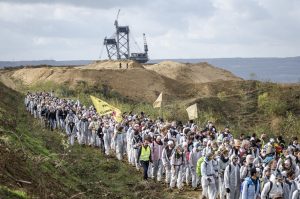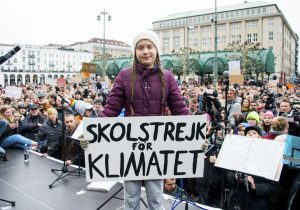Last weekend in San Francisco, my friends and I with Diablo Rising Tide hosted two friends from Germany on the “Scale Resistance” tour that Rising Tide has organized with radical climate group Ende Galaende. The talk left me thinking a lot about resistance (the real kind, not the stuff being sold by Chuck Schumer, Nancy Pelosi and the corporate Democrats). The Green New Deal is currently capturing the imagination of the progressive climate movement and becoming a centerpiece of climate “resistance.” But it needs a massive social movement moving forward at a large scale, taking serious action, at its foundation to succeed.
For the past 5 or 6 years, Ende Galaende (“Here and No Further” in English) has organized a massive nationwide coalition, that includes everyone from small radical groups to big green non-profits, to stop lignite coal mining in Germany. Their demands were an immediate phase out of lignite coal mining. Rooted in the anti-nuclear movements of a previous era, their tactic was mass disruption of coal infrastructure. Their action campaigns included mass direct actions numbering in the thousands at open pit coal mines in the Rhineland region and a multi-year tree sit in the Hambach Forest.
This critical direct action campaign has put the German political establishment on the defensive around coal and climate issues. The establishment responded with an agreement for a 20 year phase out of coal in Germany, not an immediate one as demanded by Ende Galaende. Their campaign continues.
Nationally in the U.S., the fossil fuel infrastructure fights have also challenged the legitimacy of the oil and coal industries. The hard fought campaign in the bayous of Louisiana has stopped Energy Transfer Partner’s Bayou Bridge pipeline for at least a year. Indigenous led resistance to Enbridge’s Line 3 pipeline has also put the future of that pipeline into question. In Appalachia, the locally led campaign against the Mountain Valley Pipeline that has included long term tree-sits and disruptive protest along the construction route has also delayed the completion of that project. The purveyors of the Keystone XL pipeline are also bracing for a massive social movement response. Last week, the state of South Dakota passed a set of anti-pipeline protest bills targeting both people in South Dakota, as well as any outside groups that provide support. There are dozens of these state laws being passed or proposed.
Globally, the climate and environmental uprising is spreading with ferocity as well:
- Australia: About 40 protestors took action in the Gibberagee State Forest in protest of illegal logging of koala habitat. A number of activists locked onto Forestry Corporation machinery. The action follows claims by North East Forest Alliance that an audit found the Forestry Corporation was only protecting half of the koala trees is it required to. Among the protestors was veteran forest activist Nan Nicholson, who was instrumental in saving the forest at Terania Creek in the late 1970s.
- Australia: In late February, Adani’s Abbot Point Port was targeted by anti-coal activists. Trains were stopped in a near continuous shutdown for over 75 hours during a week of non-violent direct action in central Queensland. Seven activists from across Australia, all committed to fighting the threat of thermal coal induced climate change, took action against Adani. The seven scaled fences, evaded drones, locked themselves to rail infrastructure and suspended themselves from trees and tripods to block coal trains from entering the port.
- Finland: Climate protesters climbed Finnish Parliament House pillars. Members of several Finnish environmental groups demonstrated at the Finnish Parliament on 6 March. Eight protesters were detained after scaling the giant stone columns.
- Scotland: About 20 conscientious climate protectors stayed in the National Museum of Scotland on behalf of Extinction Rebellion Scotland after closing time. They sat in to protest the ‘oil club’ dinner being hosted there tonight. A group of over 900 oil executives from the UK and beyond were gathered in a national museum and monument to celebrate their own relevance and profit-making from the destruction of the climate. 12 of our friends were arrested rather than leave after police warnings.
- Climate Strikes: Across the globe, students and youth are taking action with walkouts and mass protests to protect a future that older generations (particularly those in political and corporate offices) don’t give a shit about. Another mass climate strike is expected on March 15th.
The Sunrise Movement is already using direct action in pushing members of Congress for the Green New Deal. It kicked off with hundreds sitting in at Nancy Pelosi’s Capitol Hill offices in November with 51 arrests. A couple of weeks later on Dec. 10th, Sunrise followed up with a massive Green New Deal lobby day that included sit-ins and 143 arrests. In response to GOP Senate Majority Leader Mitch McConnell trying to stop the Green New Deal before it starts, 43 climate activists were arrested in his Capitol Hill offices in late February. In a stunning response, McConnell postponed the vote where he’d hoped to stop the Green New Deal’s march through Congress.
As Naomi Klein recently penned in the Intercept,
“I have written before about why the old New Deal, despite its failings, remains a useful touchstone for the kind of sweeping climate mobilization that is our only hope of lowering emissions in time. In large part, this is because there are so few historical precedents we can look to (other than top-down military mobilizations) that show how every sector of life, from forestry to education to the arts to housing to electrification, can be transformed under the umbrella of a single, society-wide mission.
Which is why it is so critical to remember that none of it would have happened without massive pressure from social movements. FDR rolled out the New Deal in the midst of a historic wave of labor unrest: There was the Teamsters’ rebellion and Minneapolis general strike in 1934, the 83-day shutdown of the West Coast by longshore workers that same year, and the Flint sit-down autoworkers strikes in 1936 and 1937. During this same period, mass movements, responding to the suffering of the Great Depression, demanded sweeping social programs, such as Social Security and unemployment insurance, while socialists argued that abandoned factories should be handed over to their workers and turned into cooperatives. Upton Sinclair, the muckraking author of “The Jungle,” ran for governor of California in 1934 on a platform arguing that the key to ending poverty was full state funding of workers’ cooperatives. He received nearly 900,000 votes, but having been viciously attacked by the right and undercut by the Democratic establishment, he fell just short of winning the governor’s office.
All of this is a reminder that the New Deal was adopted by Roosevelt at a time of such progressive and left militancy that its programs — which seem radical by today’s standards — appeared at the time to be the only way to hold back a full-scale revolution.”
We’re in a moment that needs massive social movement pressure to break through political and corporate barriers to respond to the climate crisis. Following the lead of organizers from our past, in other parts of the world today, the anti-infrastructure movements and the revitalized youth climate movement, it’s time to scale up and say “here and no further.”
###
Scott Parkin is a climate organizer working with Rising Tide North America. You can follow him on Twitter at @sparki1969





